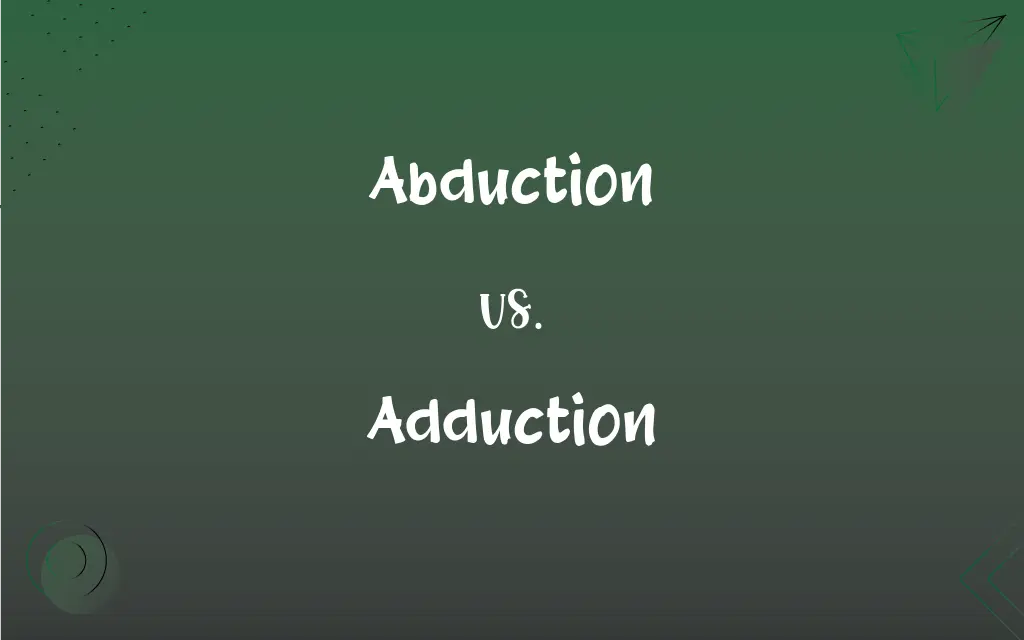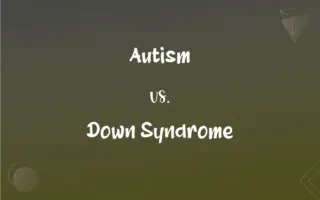Abduction vs. Adduction: What's the Difference?
Edited by Janet White || By Harlon Moss || Updated on October 27, 2023
Abduction is the movement of a body part away from the midline, while adduction brings it closer to the midline.

Key Differences
Abduction refers to the action of moving a limb or other part of the body away from the central line or midline of the body. On the contrary, adduction is the process of drawing a limb or another part of the body towards the central line or midline.
In the context of human anatomy, when you lift your arm to the side, you are performing abduction of the arm. Conversely, when you bring your arm down to your side after raising it, you are engaging in the adduction of the arm.
With regards to the fingers or toes, spreading them apart is considered abduction. In contrast, bringing the fingers or toes closer together, towards the center of the hand or foot, is termed as adduction.
Eye movements also use the terms abduction and adduction. Turning the eyes outward, away from the nose, is called abduction of the eyes. Conversely, turning the eyes inward, towards the nose, represents adduction of the eyes.
Comparison Chart
Direction of Movement
Moves body part away from the midline.
Moves body part towards the midline.
ADVERTISEMENT
Example in Limbs
Raising the arm to the side.
Bringing the arm down to the side.
Example in Fingers/Toes
Spreading them apart.
Bringing them closer together.
Example in Eyes
Turning the eyes outward, away from the nose.
Turning the eyes inward, towards the nose.
Muscles involved
Typically involves muscles termed "abductors".
Typically involves muscles termed "adductors".
Abduction and Adduction Definitions
Abduction
A motion that separates a structure from the central line of the body.
Spreading her fingers wide was a clear act of abduction.
ADVERTISEMENT
Adduction
The act of moving a body part in a direction parallel to its axis.
The yoga pose required significant adduction of the legs.
Abduction
The lateral movement of a body segment in the coronal plane.
The dancer's graceful abduction of her arms was mesmerizing.
Adduction
A motion that draws a structure towards the central line of the body.
By pressing his fingers together, he showcased adduction.
Abduction
An outward movement, especially as applied to the limbs or eyes.
The athlete practiced abduction exercises to strengthen his shoulder muscles.
Adduction
An inward movement, especially pertaining to the limbs or eyes.
He focused on adduction exercises to improve his inner thigh strength.
Abduction
The act of moving a body part in a direction that is perpendicular to its axis.
During the exercise, the abduction of her hip was evident.
Adduction
Adduction is the movement bringing a body part closer to the midline.
After stretching, she performed adduction by bringing her arm down.
Abduction
Abduction is the movement of a body part away from the body's midline.
When she raised her leg to the side, she demonstrated abduction.
Adduction
The medial movement of a body segment in the coronal plane.
The gymnast's adduction of her legs allowed her to maintain balance.
Abduction
To carry off by force; kidnap.
Adduction
To draw inward toward the median axis of the body or toward an adjacent part or limb.
FAQs
And adduction?
It's the movement of a body part closer to the midline.
How about an example of adduction?
Bringing your arm back down to your side is an example.
Do abduction and adduction only refer to arms?
No, they can refer to any body part moved away from or towards the midline.
What's the opposite of spreading fingers apart?
Bringing the fingers together, which is adduction.
How do the eyes demonstrate abduction?
By turning outward, away from the nose.
And how do they demonstrate adduction?
By turning inward, towards the nose.
Is abduction the same as extension?
No, abduction moves away from the midline while extension increases the angle of a joint.
Can the legs undergo abduction?
Absolutely, when you move your leg to the side, it's abduction.
What about for adduction?
Those are termed adductors.
Is adduction the opposite of abduction?
Yes, adduction and abduction are opposite movements.
Is it necessary to train both abduction and adduction movements in exercise?
Yes, to ensure balanced muscle development and joint health.
What does abduction mean in anatomy?
It refers to the movement of a body part away from the midline.
Can you give an example of abduction?
Yes, raising your arm to the side is an example.
Is spreading the fingers apart abduction or adduction?
It's abduction.
Are there muscles specifically for abduction?
Yes, they're called abductors.
And adduction moves a body part in which direction?
Towards the body's center or midline.
Are abduction and adduction terms used in other fields besides anatomy?
Yes, but their primary association is with anatomical movements.
What would be adduction in the context of legs?
Bringing the leg back towards the midline after moving it out.
Does abduction involve moving a body part up or down?
Not necessarily, it's more about moving away from the center.
In terms of muscle strength, why are abduction and adduction important?
They help maintain balance, stability, and the range of motion in joints.
About Author
Written by
Harlon MossHarlon is a seasoned quality moderator and accomplished content writer for Difference Wiki. An alumnus of the prestigious University of California, he earned his degree in Computer Science. Leveraging his academic background, Harlon brings a meticulous and informed perspective to his work, ensuring content accuracy and excellence.
Edited by
Janet WhiteJanet White has been an esteemed writer and blogger for Difference Wiki. Holding a Master's degree in Science and Medical Journalism from the prestigious Boston University, she has consistently demonstrated her expertise and passion for her field. When she's not immersed in her work, Janet relishes her time exercising, delving into a good book, and cherishing moments with friends and family.































































